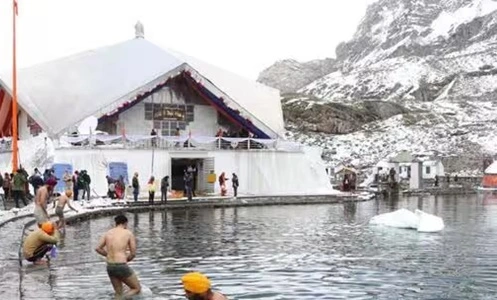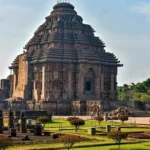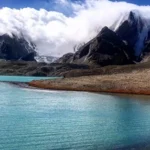Hemkund Sahib, a revered Sikh pilgrimage site located at an altitude of 4,632 meters in Uttarakhand, is one of India’s most scenic and spiritually significant destinations. Surrounded by seven snow-capped peaks and crystal-clear alpine waters, Hemkund Sahib offers an otherworldly experience for pilgrims and travelers alike. This sacred gurudwara, dedicated to Guru Gobind Singh Ji, the tenth Sikh Guru, draws thousands of devotees and trekkers each year, especially during the summer season when the journey to the shrine is accessible.
The best time to visit Hemkund Sahib is vital to ensure safe travel, comfortable weather, and a memorable experience in the Himalayas. The shrine is only open for a few months each year due to heavy snowfall and extreme conditions at high altitudes. Here’s a guide to help you plan your visit to Hemkund Sahib, from when to go to what you can expect during each season.

The Spiritual and Natural Beauty of Hemkund Sahib
Hemkund Sahib is as much about spirituality as it is about natural beauty. The gurudwara sits beside a glacial lake that mirrors the surrounding peaks, creating a serene, tranquil setting. The lake’s crystal-clear water and the surrounding landscape of wildflowers, including the famous Brahma Kamal, add to the charm of this holy site. The journey to Hemkund Sahib requires a challenging trek from Govindghat, passing through the beautiful Valley of Flowers and the village of Ghangaria.
This arduous journey is a test of both physical endurance and spiritual faith, as devotees brave the steep paths to reach the gurudwara. Once at the top, visitors find solace and spirituality at the gurudwara, often taking a dip in the freezing waters of Hemkund Lake as an act of devotion.
Best Seasons to Visit Hemkund Sahib
1. Summer (June to September)
The best time to visit Hemkund Sahib is during the summer months from June to September, as this is when the gurudwara is open to pilgrims. The weather during this period is relatively mild, with daytime temperatures ranging from 10°C to 20°C. However, nights can still be cold due to the high altitude, so warm clothing is essential.
Summer is the peak pilgrimage season, and the trail leading to Hemkund Sahib becomes lively with thousands of devotees and trekkers. The paths are lined with wildflowers, and the famous Valley of Flowers blooms in vibrant colors during July and August. The scenic beauty of the trail, combined with the spiritual fervor of the pilgrims, creates an inspiring and uplifting atmosphere.
For those interested in botany, the Valley of Flowers, which is part of the route, is a UNESCO World Heritage Site and is in full bloom during the summer. The sight of Brahma Kamal, blue poppies, and other rare alpine flowers is mesmerizing, and the area’s biodiversity is remarkable.
Starting your trek early in the morning from Ghangaria is advisable to avoid the afternoon mist that sometimes blankets the peaks. The summer months also provide more stable weather, making the trek relatively safer and more accessible. However, be prepared for a strenuous climb, as the trek from Ghangaria to Hemkund Sahib is steep, covering around 6 kilometers at a high altitude.
2. Monsoon (July to August)
The monsoon season overlaps with the summer months, particularly in July and August, bringing frequent rainfall to the region. While the Valley of Flowers is at its most vibrant during this period, with lush greenery and blooming flowers, the rains also make the trek more challenging. The paths can become slippery, and landslides are a possibility, so extra caution is necessary for those visiting during the monsoon.
Despite the risks, many pilgrims and trekkers choose to visit during the monsoon to witness the Valley of Flowers in its full glory. The trail is alive with a wide variety of flora, and the views are breathtaking, with mist and clouds drifting over the mountains. For nature enthusiasts and photographers, the monsoon season offers unparalleled beauty, though waterproof gear and proper trekking equipment are essential to manage the rainy conditions.
3. Autumn (September)
September is one of the best times to visit Hemkund Sahib, as the monsoon rains have subsided, leaving behind clear skies and fresh mountain air. The temperature in September ranges from 5°C to 15°C, making it comfortable for trekking. The paths are drier and more accessible, while the flowers in the Valley of Flowers are still in bloom, although they start to fade as autumn progresses.
The autumn season offers excellent visibility, allowing trekkers to enjoy unobstructed views of the surrounding peaks and valleys. The crowds begin to thin in September, providing a more peaceful experience for visitors who prefer a quieter pilgrimage. As the season progresses, nights become colder, so it’s advisable to carry warm clothing.
The gurudwara usually closes in early October, depending on the weather and snowfall forecasts. September offers a last opportunity to visit Hemkund Sahib before the onset of winter, when the region becomes inaccessible due to snow.
Winter (October to May)
During the winter months, Hemkund Sahib is closed to visitors due to heavy snowfall and extreme temperatures that can drop below -10°C. The region becomes blanketed in snow, making the trek dangerous and impossible to navigate. The gurudwara is reopened only when the snow starts to melt in late spring, usually around late May or early June.
While visiting Hemkund Sahib in winter is not feasible, those interested in exploring the region’s winter beauty may consider other accessible destinations in Uttarakhand, such as Auli or Mussoorie, which offer stunning snowy landscapes.
Practical Tips for Visiting Hemkund Sahib
- Acclimatization and Fitness: Hemkund Sahib’s high altitude requires visitors to be well-prepared physically. Spending a night in Ghangaria to acclimate before the final trek is highly recommended to minimize the risk of altitude sickness.
- Clothing: Dress in layers, as temperatures can vary widely between day and night. Even in summer, carry a warm jacket, gloves, and woolen caps, as the high altitude brings chilly winds.
- Permits: Foreign nationals may require permits to enter the Valley of Flowers, as it is a protected area. It’s advisable to check with local authorities or tour operators for any entry requirements.
- Trekking Essentials: Carry essentials like water, energy bars, and first-aid kits. Walking sticks and proper trekking shoes are also highly recommended, as the trail can be steep and challenging.
- Best Time of Day for the Trek: Starting the trek early from Ghangaria is advisable, as it allows you to reach Hemkund Sahib by midday, before the weather starts to change in the afternoon.
- Respecting the Environment: Hemkund Sahib is a sacred place and an ecologically sensitive area. Visitors are encouraged to respect the environment, avoid littering, and follow the Leave No Trace principles to preserve the natural beauty of the region.
Conclusion
Hemkund Sahib offers an experience that is both spiritually uplifting and visually awe-inspiring. From the verdant beauty of summer to the calm serenity of early autumn, each season brings something unique to this high-altitude shrine. Whether you’re on a pilgrimage or seeking an adventurous trek, Hemkund Sahib rewards visitors with stunning landscapes, sacred serenity, and a profound sense of peace. By planning your trip for the optimal season, you can fully appreciate the majesty of Hemkund Sahib and the surrounding Himalayan wilderness.


